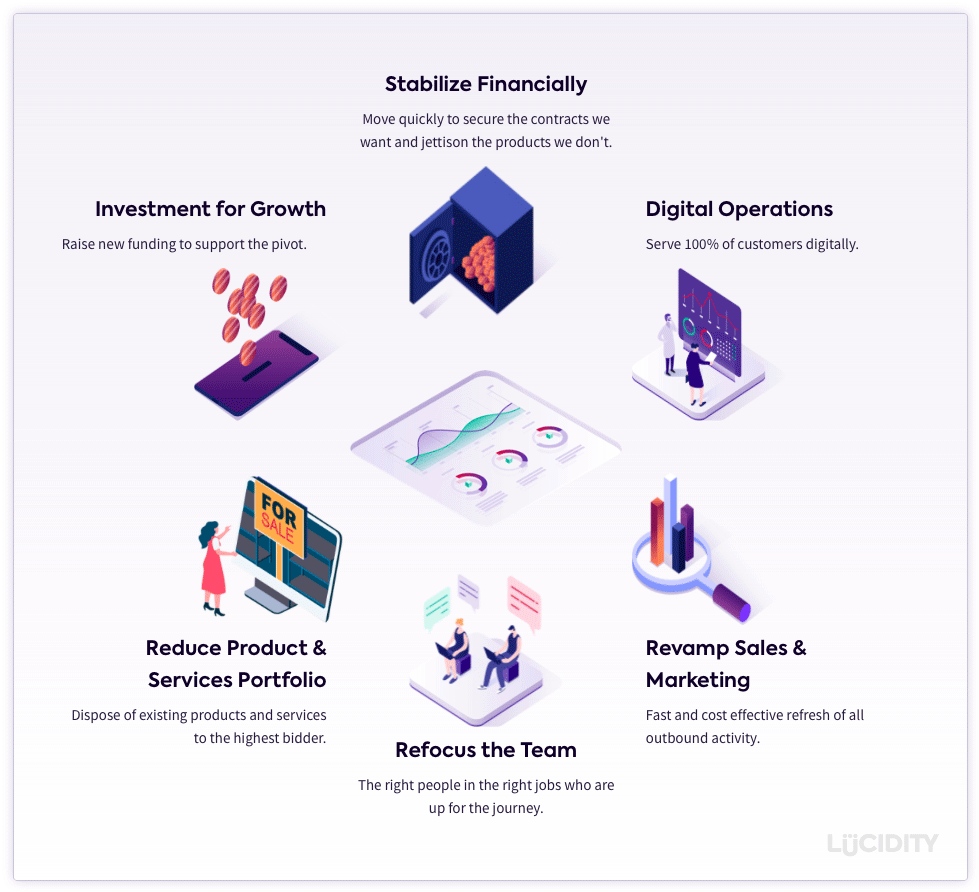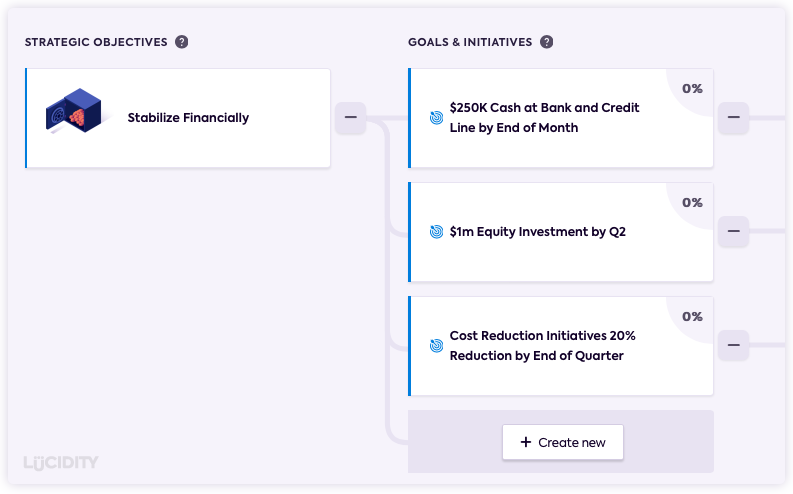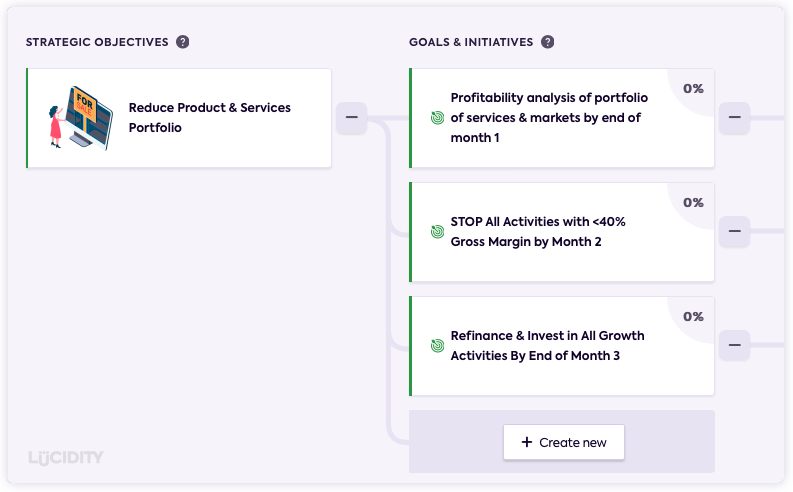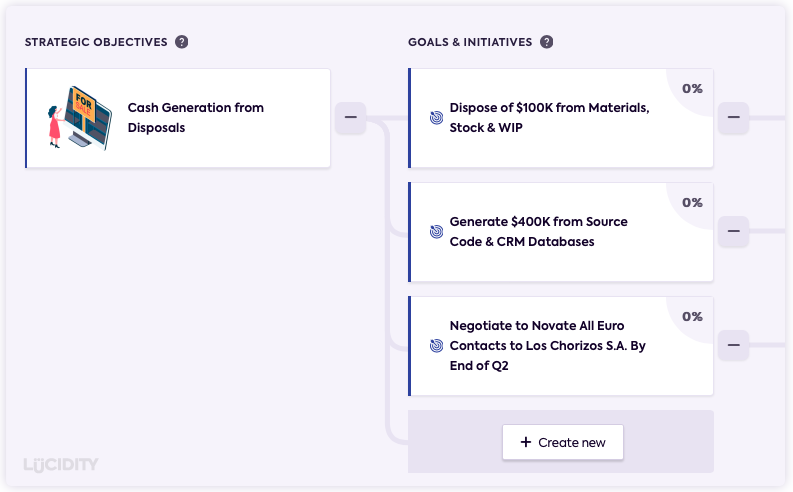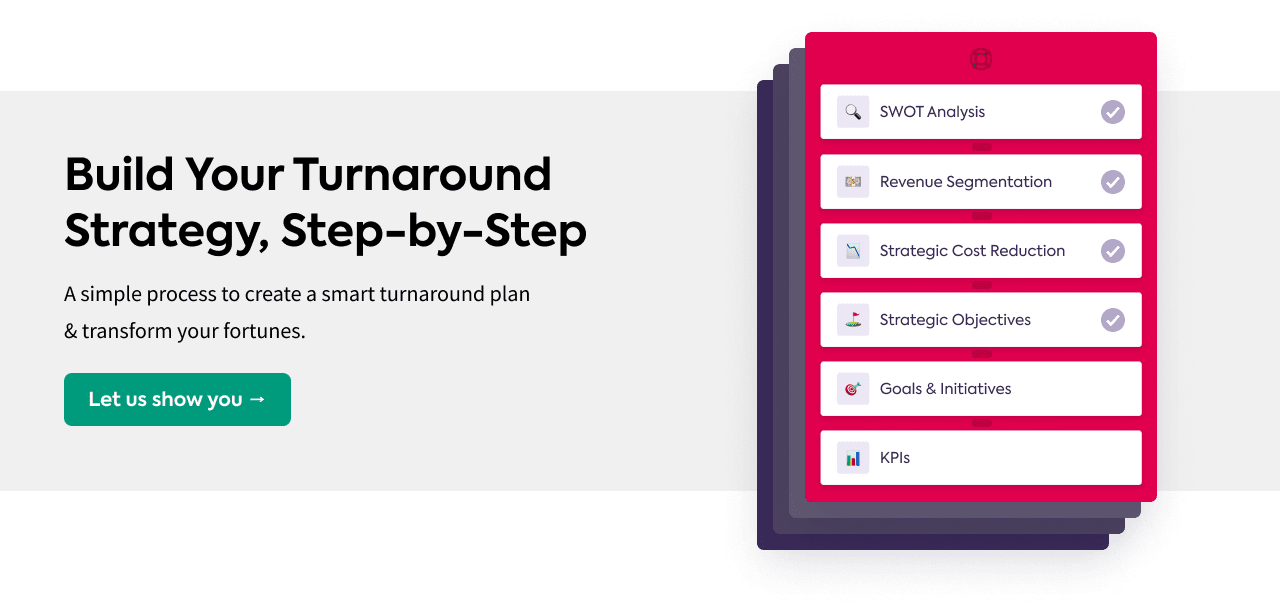If your business is struggling or in trouble you’ll need to start thinking about the best strategy to turn it around. But what does a turnaround strategy look like in terms of strategic objectives, goals and initiatives? And what other considerations are there when you are fighting for survival?
Of course, every situation is different but let’s look at some ideas that may help you to think through priorities in a structured way, and help you build your plan to get the business back on track.
The image above shows typical topics or activities that are at least under discussion as part of a turnaround and most of these things will likely become strategic objectives, goals, initiative and tasks.
Getting Financially Stable
How much cash do you have at the bank? How much committed revenue do you have coming in over the next three months and what are your outgoings? How much new investment could you raise?
Despite being under pressure now, if you’ve got the right vision and a solid turnaround strategy you could raise investment and arguably should try to. Perhaps your Financial Stability strategic objective, goals and initiatives look something like this. Note good practice around the activities – measurable activities, timebound and with clear accountability:
You should also have a think about how often you or members of the team need to review your cash position. It’s not unusual in a turnaround situation to have to manage cash in and cash out on a daily basis, with the CEO/MD meeting the CFO/FD every day to understand what’s coming in and which payments out to prioritize.
Reducing Portfolio of Activities
Arguably one of the most critically important activities in a turnaround strategy, or any strategy for that matter, is deciding where to focus. Continuing or stopping products, services, markets, locations etc is a critical thing to get right.
There’s a simple but powerful tool to use here called Start Stop Continue. This is illustrated in detail here, take a look.
As shown, you should CONTINUE things that are generally good for the business – healthy, profitable, not too challenging, stable to growing. That’s generally the easy bit. The difficult bit, and our focus here, is what to STOP and its quite common for businesses to get into trouble because they do not do this. They get bogged down with too much “stuff” that keeps everyone busy but doesn’t deliver results and isn’t going anywhere. So be brave, read the above, and get the knife out. Because stopping low value activities creates the space and oxygen in the business that allows you to focus on the things that are going to help you turn the business around – the things you need to START doing.
So, STOP:
- Low revenue and profit – any activity that has these characteristics – there’s no point continuing this stuff. STOP.
- Low growth – if you are spending time/effort/resources on something that isn’t growing, then neither will you. STOP.
- In decline longer term – get off the bus now. STOP.
- Resource intensive for you – being busy may feel good but if something uses up a disproportionate amount of energy for little return then STOP.
- Difficult in some way – quit while you can. STOP.
- Any toxicity for your business – these can be real killers. A toxic customer > people get demotivated and leave > you can’t rehire etc. Stop these vicious circles – it could be a product, a market, a geography, a service, a client, a customer segment. STOP!
- Highly competitive – if competitive rivalry is too high to grow or make a profit then there is nothing bad in analyzing that properly and getting out. STOP.
- No USP, you can’t defend yourself – if you can’t compete with a strong USP then it may be time to STOP.
Whilst this may be painful and mean difficult decisions, it is worth it. Going through this process can be the most transformative thing for your business. You will be left with fewer activities, of higher value and quality, higher potential and be able to really focus on driving results and being successful rather than feeling like the business is on the back foot all of the time.
Strategic Objectives, goals and initiatives could be:
Disposing of Assets
One of the benefits of going through Start, Stop, Continue is that the assets from the things you stop doing may have some value to someone else. You can sell these assets to someone else in the marketplace, to raise some money to fund your turnaround.
Consider:
- Unwanted products – these could be stocks of materials or goods that are no longer required. Who would value them?
- Intellectual property – assets here could be designs, trademarks, patents, proprietary software, data/databases, certain documented insight, content, anything that you have the copyright for. Who would value these things?
-
Unwanted client contracts – do you have ongoing contracts with clients that can be novated over to other providers who do the same thing or would see taking on the contracts as a growth opportunity? It’s good to find a home for customers or even partners.
Securing Your Most Important Customers
Of course, there will be customers that you need to look after. If your business is in trouble, then there’s a very good chance that your customers will know about it. One reason will be that if your competition is aware of your situation – staff leaving and applying for jobs with stories of woe – then its highly likely that your biggest customers will be aware.
It’s therefore critical to communicate and re-contract with the customers that are the most important to you moving forward. Logic says these are your largest, your most profitable, strategically valuable and strategically relevant customers. You need a solid communication plan for your clients to get the right message across clearly at the right time to the right people.
What could this part of a turnaround strategy look like in terms of strategic objectives, goals and initiatives?
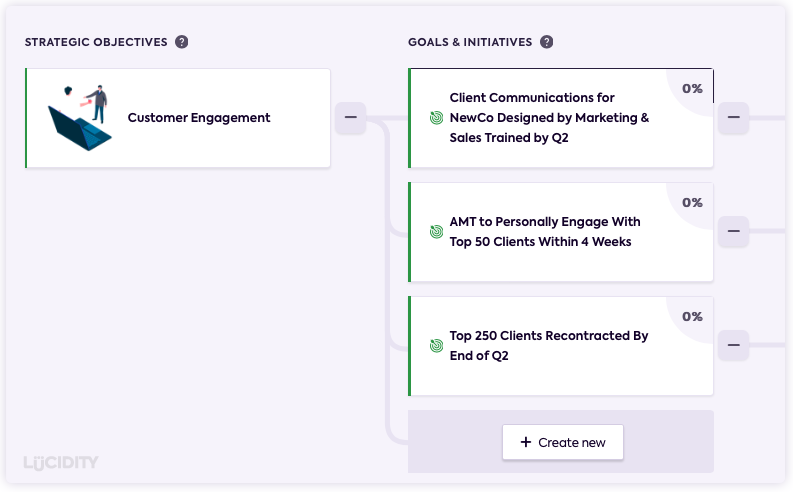
Revamping Your Sales & Marketing
This is a broad set of activities so we will not exhaustively cover everything here. The turnaround strategy should drive the sales strategy and the sales strategy drive the marketing strategy. The approach and tempo with sales and marketing must deliver a sharp refocus, provide new, clear value propositions for new client personas, appropriate messaging, financial targets and incentives that stack up for company and teams alike. Have a think about some of the points raised below and what else you need to do.
Refocusing the Team
People; arguably the toughest or potentially most emotionally fraught area to deal with in a turnaround situation. It’s likely some people will be lost. If you are stopping certain activities / products / customer segments / geographies / offices and even stopping certain teams then of course this could regrettably mean losing some people.
The survivors will have lost colleagues and, in some cases, good friends. Survivor guilt, a loss of trust and/or morale at a time when you need laser sharp focus, high energy and good morale to drive new activities and push forward. This is tough and requires excellent leadership.
Communication is absolutely critical at times like this. It cannot be stressed enough – you cannot over communicate. For this area then let’s consider a well-tested change leadership approach Kotter’s 8 Steps to get you thinking.
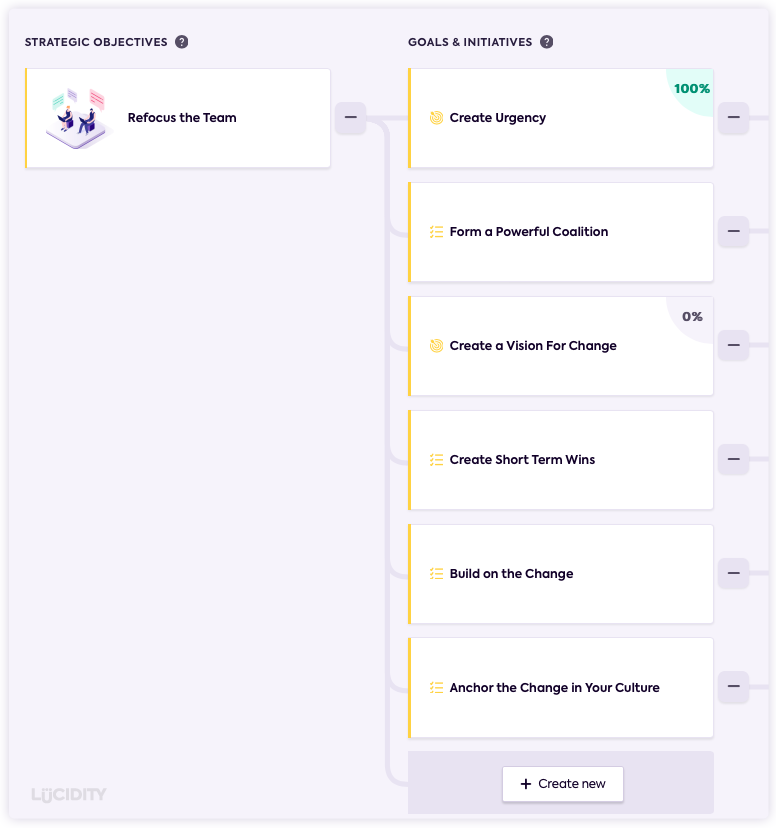
Honing Your Operations
Operational considerations in a turnaround strategy typically fall into three pots. Everything needs to go into one of the pots:
- What are you going to keep in house?
- What can go outside and be provided as a service?
- What can be digitized to provide better scaling or cost effectiveness?
An additional consideration here is around decision making. If you’ve got two months’ worth of cash in the bank then rapid decision making will be key to survival, so who is going to be involved in making decisions and how those decision will be made is a good thing to understand quickly and early. Perhaps, like cash management, decision making during a turnaround situation becomes a daily session.
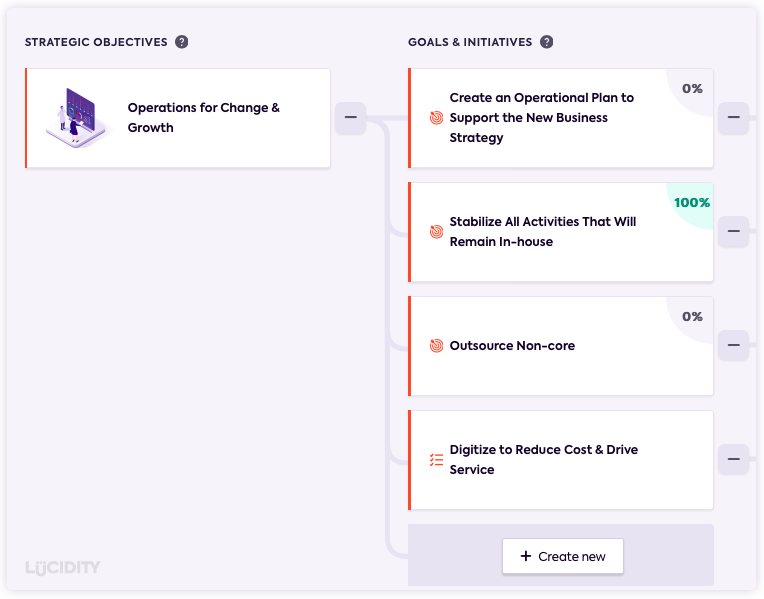
Summary of How to Turnaround
-
Recognize why things have become distressed – this can inform your turnaround strategy more than you realize. Check out our article on three of the most common reasons.
-
Use Tools to understand your options and way forward – be objective, be structured, use data. Take time to figure out what to do and where to focus. Read our guide to the best tools to build your turnaround strategy.
-
Build out appropriate strategic objectives and goals – be structured in your approach when planning what to do. 5-6 Strategic Objectives supported by some Goals and Initiatives. Communicate this to the team – be visual when communicating this. No one gets inspired by a spreadsheet.
-
Don’t waste time on the unimportant – speed and accountability are critical. You don’t have time to waste, everything needs to speed up, make decisions quickly. And in terms of accountability it’s essential that everyone is crystal clear on who is responsible for what. You don’t have the time to take a few weeks for two managers to figure out who is accountable for what.
-
Communicate to all stakeholders regularly – communicate, communicate, communicate to employees, customers, suppliers, partners, investors. You’ll be surprised at the help and engagement you can get and that could be the difference between success and failure.
Good luck – go and turn that corner!

